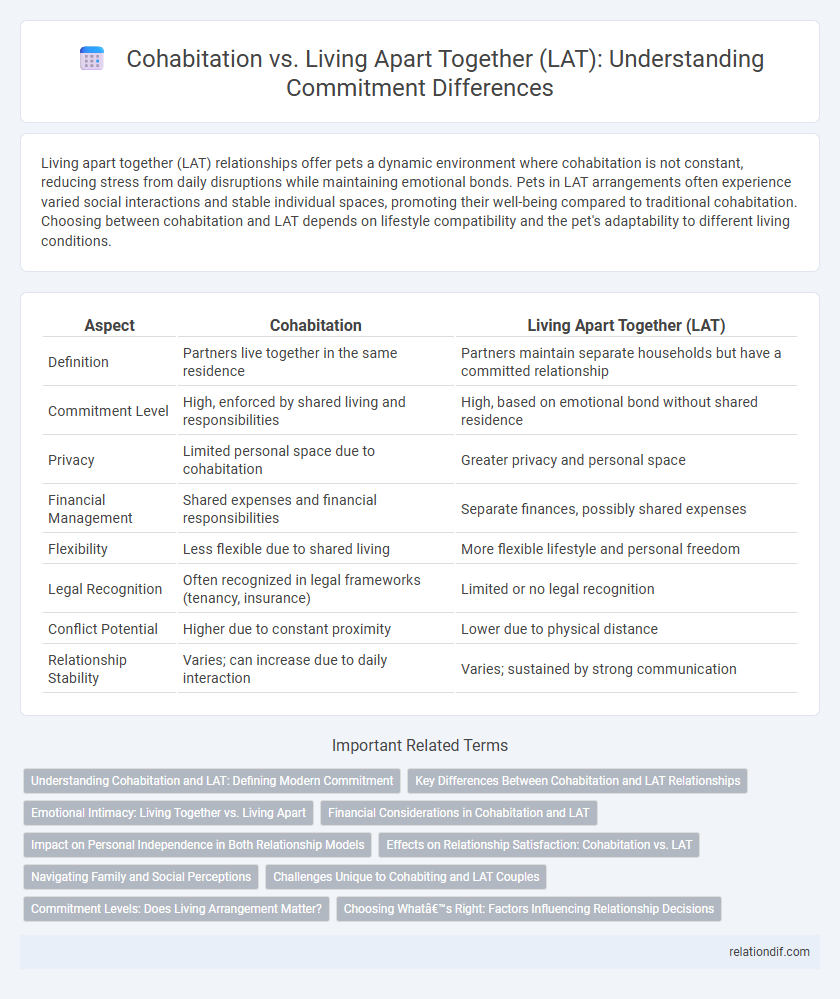Living apart together (LAT) relationships offer pets a dynamic environment where cohabitation is not constant, reducing stress from daily disruptions while maintaining emotional bonds. Pets in LAT arrangements often experience varied social interactions and stable individual spaces, promoting their well-being compared to traditional cohabitation. Choosing between cohabitation and LAT depends on lifestyle compatibility and the pet's adaptability to different living conditions.
Table of Comparison
| Aspect | Cohabitation | Living Apart Together (LAT) |
|---|---|---|
| Definition | Partners live together in the same residence | Partners maintain separate households but have a committed relationship |
| Commitment Level | High, enforced by shared living and responsibilities | High, based on emotional bond without shared residence |
| Privacy | Limited personal space due to cohabitation | Greater privacy and personal space |
| Financial Management | Shared expenses and financial responsibilities | Separate finances, possibly shared expenses |
| Flexibility | Less flexible due to shared living | More flexible lifestyle and personal freedom |
| Legal Recognition | Often recognized in legal frameworks (tenancy, insurance) | Limited or no legal recognition |
| Conflict Potential | Higher due to constant proximity | Lower due to physical distance |
| Relationship Stability | Varies; can increase due to daily interaction | Varies; sustained by strong communication |
Understanding Cohabitation and LAT: Defining Modern Commitment
Cohabitation involves partners sharing a residence and daily life, reflecting a traditional form of commitment with intertwined routines and joint responsibilities. Living Apart Together (LAT) relationships maintain emotional intimacy without shared living spaces, offering autonomy while sustaining commitment through mutual trust and communication. Both models exemplify modern commitment by balancing personal independence and relational connection tailored to individual needs and lifestyle preferences.
Key Differences Between Cohabitation and LAT Relationships
Cohabitation involves partners sharing a common residence and daily responsibilities, creating an intertwined domestic life that often mirrors traditional marriage without formal legal ties. LAT (Living Apart Together) relationships maintain emotional intimacy and commitment while preserving individual living spaces, allowing for greater personal independence and boundary management. Key differences include the physical proximity, shared household obligations, and the degree of daily interdependence, which impact relationship dynamics and legal recognition.
Emotional Intimacy: Living Together vs. Living Apart
Cohabitation fosters daily emotional intimacy through shared routines and constant physical presence, deepening relational bonds. Living Apart Together (LAT) allows partners to maintain individual space while nurturing emotional connection, promoting autonomy and reducing dependency. Emotional intimacy in LAT relies heavily on intentional communication and quality time, contrasting with the natural closeness experienced in cohabitation.
Financial Considerations in Cohabitation and LAT
Financial considerations in cohabitation often include shared expenses such as rent, utilities, groceries, and joint savings, which can lead to greater economic efficiency and resource pooling. In contrast, Living Apart Together (LAT) partners tend to maintain separate finances, reducing financial interdependence but preserving individual economic autonomy. Budgeting for LAT relationships typically involves managing two households, which may increase overall cost but allows for distinct personal financial control and risk management.
Impact on Personal Independence in Both Relationship Models
Cohabitation often entails shared responsibilities and daily interactions that can challenge individual autonomy, whereas Living Apart Together (LAT) relationships typically preserve personal independence by maintaining separate living spaces. Partners in LAT arrangements benefit from increased freedom to pursue personal interests and routines without negotiation over shared household dynamics. Maintaining separate residences enables both relationship models to balance intimacy with autonomy, but LAT prioritizes personal independence more explicitly.
Effects on Relationship Satisfaction: Cohabitation vs. LAT
Cohabitation often leads to higher relationship satisfaction through increased daily interaction and shared responsibilities, fostering emotional closeness and mutual support. In contrast, Living Apart Together (LAT) arrangements provide partners with greater personal space and autonomy, which can reduce conflict and promote individual well-being but may limit emotional intimacy. Research indicates that the effectiveness of each arrangement on satisfaction varies based on factors such as communication quality, trust, and alignment of long-term goals.
Navigating Family and Social Perceptions
Cohabitation often faces societal assumptions about traditional commitment, creating expectations for formal progression or shared responsibilities, while Living Apart Together (LAT) relationships challenge these norms by prioritizing individual autonomy within partnership. Navigating family perceptions in LAT arrangements requires clear communication to address concerns about stability and legitimacy, as many families equate physical proximity with commitment strength. Understanding these social dynamics enables couples to redefine commitment on personal terms, balancing closeness with independence amid evolving social frameworks.
Challenges Unique to Cohabiting and LAT Couples
Cohabiting couples often face challenges such as negotiating shared responsibilities, managing conflicts over space and finances, and addressing societal expectations tied to their living arrangement. LAT couples, while maintaining emotional intimacy, struggle with logistical issues like coordinating time together and dealing with perceptions of less commitment from others. Both arrangements require clear communication and boundaries to navigate the complexities of commitment in non-traditional relationships.
Commitment Levels: Does Living Arrangement Matter?
Cohabitation often signifies a higher commitment level due to daily interactions and shared responsibilities, fostering relationship stability and emotional intimacy. Living Apart Together (LAT) allows couples to maintain independence while sustaining emotional bonds, often reflecting a commitment based on personal space and long-term partnership goals. Studies show commitment intensity correlates more with mutual understanding and future planning than solely living arrangements, suggesting that physical proximity is not the exclusive indicator of relationship dedication.
Choosing What’s Right: Factors Influencing Relationship Decisions
Commitment decisions between cohabitation and Living Apart Together (LAT) hinge on personal values, emotional needs, and lifestyle priorities. Cohabitation often appeals to couples seeking daily intimacy and shared responsibilities, while LAT suits those valuing independence and individual space. Relationship satisfaction depends on mutual understanding of expectations, communication styles, and long-term goals.
cohabitation vs LAT (Living Apart Together) Infographic

 relationdif.com
relationdif.com